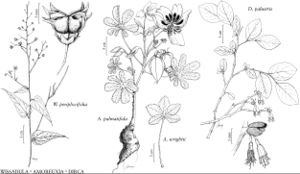Difference between revisions of "Amoreuxia wrightii"
Smithsonian Contr. Knowl. 5(6): 26. 1853.
FNA>Volume Importer |
imported>Volume Importer |
||
| Line 51: | Line 51: | ||
|publication year=1853 | |publication year=1853 | ||
|special status=Illustrated | |special status=Illustrated | ||
| − | |source xml=https:// | + | |source xml=https://bibilujan@bitbucket.org/aafc-mbb/fna-data-curation.git/src/bb6b7e3a7de7d3b7888a1ad48c7fd8f5c722d8d6/coarse_grained_fna_xml/V6/V6_700.xml |
|genus=Amoreuxia | |genus=Amoreuxia | ||
|species=Amoreuxia wrightii | |species=Amoreuxia wrightii | ||
Revision as of 23:43, 27 May 2020
Stems 15–50 cm, glabrous or sparsely lanulose-puberulent (mostly on young growth), glandular. Leaves: petiole 3–8 cm, subglabrous to sparsely lanulose-puberulent (mostly on young growth), glandular; blade 5(7)-lobed, 3–5 × 4–7 cm, lobes subrhombic, distal half of margins serrate, apex rounded to acute, tooth of central lobe apex most distal. Peduncles 2.5–5 cm. Flowers 3–7.5 cm diam.; sepals narrowly oblong-ovate, 17–20 × 5–8 mm, apex acute; petals pinkish to orange, distal petals with 2 conspicuous purplish marks at bases, lateral petals each with 1 purplish mark at base; distal set of filaments 5–10 mm with yellow anthers, proximal set of filaments 11–17 mm with usually dark red anthers; ovary usually short-haired-lanate to tomentose or puberulent (glandular). Capsules oblong-obovoid, 3–6 cm, sparsely pubescent (glandular). Seeds globose to ovoid, glabrous. 2n = 12.
Phenology: Flowering May–Jul(–Oct).
Habitat: Dry, rocky or gravelly hills, plains, deserts, grasslands, shrublands, along roads or railroads, limestone soil, silty flats
Elevation: 0–400 m
Distribution

Tex., Mexico, West Indies (Curaçao), South America (Peru).
Discussion
Amoreuxia wrightii is morphologically homogeneous throughout its disjunct range (H. H. Poppendieck 1981).
Selected References
None.
